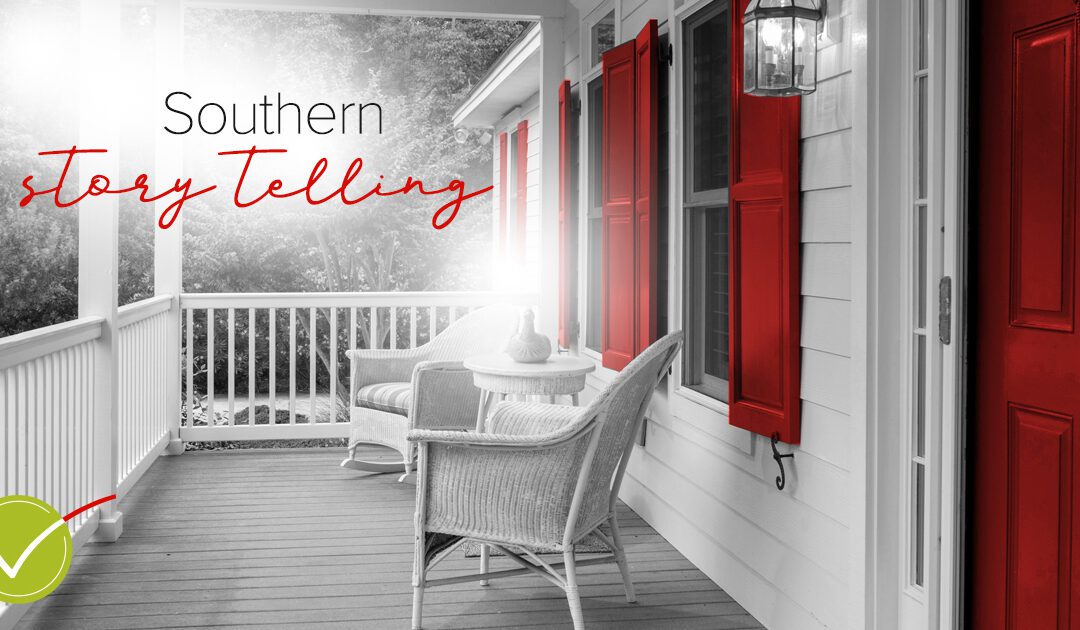My friend Mary Beth from Mobile, Alabama once told me something foundational about Southern culture: “You can commit any number of crimes and still be invited back to a party, except for one: being a bore.”
It turns out, that quirky, wonderful aspect of Southern culture is often the case in business, too. Just like Southern partygoers, customers and employees will be more interested in and engage with leaders and companies that capture their attention.
And when you have captured their attention, interest and engagement, that’s where the magic happens. Company culture shifts when employees can see the big picture and can follow your vision. When they can see the vision for themselves, they get inspired for change. New customers become lifelong loyal customers. Sales and revenue grow like Jack’s proverbial beanstalk (or if you’re in the South, like kudzu).
What’s the most reliable way to capture people’s attention and move them to action? Storytelling.
Good communicators are good storytellers.
Humans have been telling each other stories forever. We’ve told stories about our greatest achievements to inspire us for more and stories to warn our children about the dangers that lurk in the woods so they can stay safe. Stories connect people through their shared experiences, values, and emotions. The emotions embed the stories within them, too, and they remember.
Great businesses already recognize this, of course. Steve Jobs built Apple on intuitive products, yes, but also on the power of the story around them.
“The most powerful person in the world is the storyteller. The storyteller sets the vision, values and agenda of an entire generation that is to come.” – Steve Jobs
Not every company can have a Steve Jobs, but the greatest companies have invested massively in public relations departments to tell their stories. As Scott Galloway pointed out, across Amazon, Apple, Google, Meta, and Microsoft there are now almost as many PR/comms employees as there are screenwriters in America. It’s an industry worth billions for a reason.
Stories bring your brand to life with authenticity, connection, and emotion. They can inject humor, richness, and relatability. Those are the things that inspire.
Southern storytelling especially has always fascinated me, partly because it seems like there are just so many people in the South who are great storytellers. My own Southern grandma was one of those enthralling storytellers whose gestures and words put you right at the scene. (She always got invited to the best parties, of course.)
So how do you tell a good story? You take a few lessons from Southern storytelling.
Set the scene.
The scene is the first foundation of any story. Where are you? What are you working within? What’s the problem you’re facing?
Great Southern writers use such rich imagery that you feel as if you’re right there, scorching your skin under the blazing sun or struggling to catch a full breath in the heavy, humid air. In Gone with the Wind, Margaret Mitchell didn’t just mention the breathtakingly hot morning. She wrote, “The air was oppressive even in the early morning hour, hot with the scorching promise of a noon of glaring blue sky and pitiless bronze sun.”
Are you reaching for a fan or a cold sweet tea yet? Describing a scene or a problem in a colorful way reminds people of what it feels like to face it themselves.
Stop using corporate-speak
Corporate culture can be stifling, especially in large organizations. Those who are immersed in their corporate roles speak to each other all day in industry-specific terms and business buzzwords. Those words can be great when they are specifically focused on the tasks at hand.
However, corporate-speak focuses on the “what,” not the “why.” The “why” is important—to customers, investors, and even employees. The stories you tell are the picture of the “why.” They humanize your brand.
What will grip their attention and tap into their hearts? You don’t connect to people through buzzwords; you connect through emotions. Emotional connections make a story memorable.
Tell them who you are
When you tell the story of your journey—the moments, the troubles, and the triumphs—it shows people who you are. It illustrates your values without you having to preach them.
When you talk about what you’re still working on, it’s relatable. If you can do that with humor, that’s even better.
People want to feel like they’re part of the story. If they don’t, how can they go with you?
—-
What is the story you need to tell? Are you trying to implement culture change in your company? Are you trying to build your brand? Borrow the techniques of great Southern storytellers to engage, entertain, and inspire. Let me know if you need help. I’d love to work with you.


Jeannine, darling, you know how highly I regard you but I gotta tell ya: I’m not a big fan of the concept of “storytelling”. But I want to obliterate the word “passionate” when it’s used for banalities. Years ago it became what “amazing” is today. It’s like ivy and wisteria you can’t root out. And don’t even get me started on “narrative”. So threadbare it blows away like a dandelion but, like “woke”, took on a life of its own and now we’re stuck. Passionate? I’m passionate about sex, really great food, jazz, Puccini arias and everything Italian. So there! Keep up your great work! And, hey, maybe I’m too passionate about this topic?
Stan, As an observer of language I would tend to agree with you…the word storytelling is beginning to make me sleepy. Yawn…Passionate? Let’s try to keep the concept…maybe use fiery instead, like a fiery redhead. I’m fiery about all you’re passionate about and then some..let’s add wine and the French countryside. Thanks for reading. Jeannine